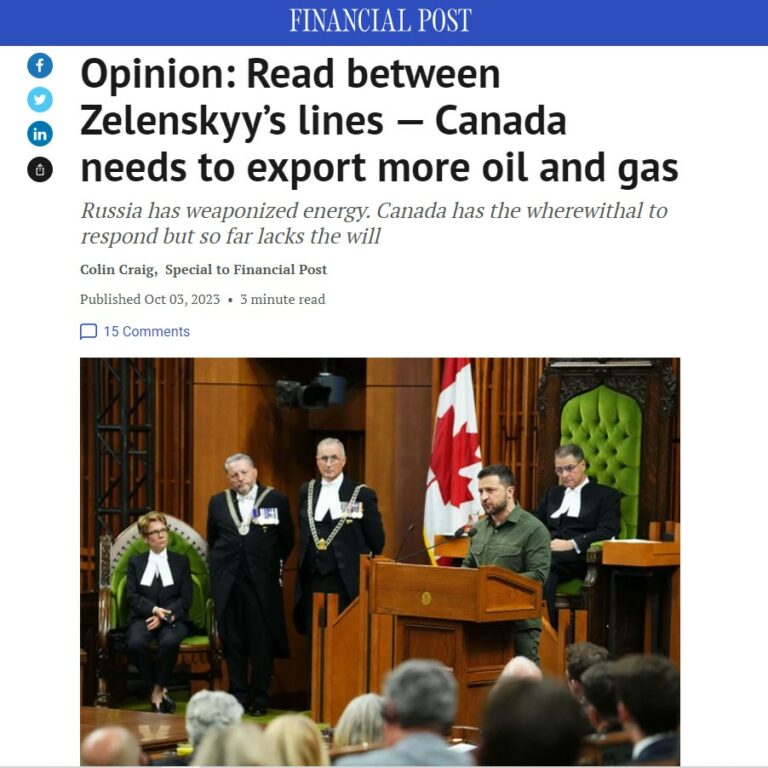Shortly after Ukraine President Volodymyr Zelenskyy’s recent speech to Parliament, his message was lost in an explosion of media coverage over a standing ovation given to a controversial (to say the least) Second World War veteran.
FINANCIAL POST COLUMN: Read between Zelenskyy’s lines — Canada needs to export more oil and gas

It’s important however for Canada to return to the subtle but clear message in Zelenskyy’s speech about what’s going on in the world and how, in response, Canada needs to export more oil and natural gas.
As Zelenskyy said: “Russia uses nuclear technology, and the construction of nuclear power plants, like gas and oil, for political attacks against the sovereignty of other nations. Russia is trying to break the sovereignty of others through its manipulation of energy resources … all energy resources. So, the more nations are free from Russian energy resources, the sooner energy in the world will once again become just an energy resource, not a weapon against sovereignties.”
“The more nations are free from Russian energy resources …” Why would Zelenskyy make this point to the parliament of a country that doesn’t buy oil and natural gas from Russia anymore? Because he knows Ottawa’s policies have kept Canada from building pipelines and exporting oil and gas to countries that are buying Russian energy resources. If these other countries purchased more of their oil and gas from Canada and less from Russia, then Vladimir Putin would have fewer dollars to buy tanks and rockets to attack Ukraine with. The connections aren’t complicated.
Despite Western sanctions, including boycotts of Russian oil, Russia’s revenues from petroleum exports are up an estimated $15 billion this year, according to the Kyiv School of Economics. While the EU has drastically cut back on Russian crude purchases, an increase in Russian oil sales to India and the general rise in the world price have made up for it.
Zelenskyy couldn’t be too pushy about this issue on Canadian soil, of course. Our federal government has committed a reported $9.5 billion to Ukraine since the war began. The Ukrainian president needs all the help he can get. Criticizing Ottawa for its energy policies would be kicking a gift horse in the mouth.
Last year, research by SecondStreet.org concluded that if Canada made it a priority to develop and export our oil and natural gas resources, we could replace about half of Russian energy sales by the end of the decade. It’s hard to think of a more effective way to pull the rug out from under Putin.
As the war drags on, it’s easy to forget what’s happening overseas. As we in the West worry about what we’re having for dinner or our weekend plans, Ukrainians are worried about being attacked in the middle of the night and Russian forces abducting their children or worse.
Filmmaker Olesya Shyvikova told SecondStreet.org about a conversation she had recently with a Ukrainian farmer turned soldier. Through Zoom, she asked him about a grenade that she saw in his shirt pocket. He told her he carries two at all times in case he’s captured. One is for throwing at Russian soldiers and the other is for taking his own life, given the atrocities some Russians have been accused of committing.
Ottawa needs to get over its fixation on climate change and recognize there are other serious threats to the existing world order. Zelenskyy is obviously right: Putin is using energy as a weapon. And his forces are hurting people in ways that seem unfathomable in our peaceful nation.
If Canada built more pipelines and exported more oil and gas, Ottawa could make a small fortune in tax revenues. It could use those dollars to both “fight climate change” and help Ukraine fight Russia. That would make more sense than the status quo. Read between Zelenskyy’s lines and it’s clear he agrees.
Colin Craig is president of the think-tank SecondStreet.org.
This column was originally published in The Financial Post on October 3, 2023.
You can help us continue to research and tell stories about this issue by making a donation or sharing this content with your friends. Be sure to sign up for our updates too!


